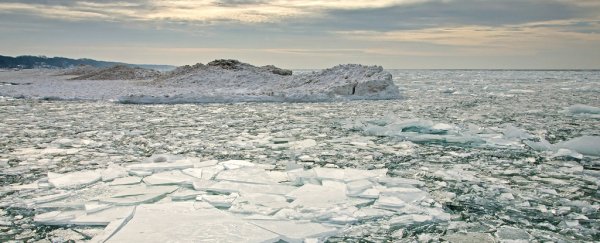Earth is in a pretty unique state of climate change at the moment, but for the past 1 million years, almost like clockwork, our planet has moved in and out of an ice age every 100,000 years.
The only problem is, researchers have never really been able to figure out why. In fact, they've been so puzzled by the mysterious phenomenon, they've labelled it the '100,000 year problem'. But now a new study might finally have the solution.
New research suggests that our oceans might regularly suck more CO2 out of the atmosphere every 100,000 years, allowing the planet to get cold enough to trigger an ice age.
The '100,000 year problem' stems from the fact that around 1 million years ago, Earth started experiencing ice ages - vast ice sheets covering North America, Europe, and Asia - every 100,000 years.
Before this point, which is known the mid-Pleistocene transition, our planet's ice ages used to occur at intervals of every 40,000 years, which made a lot more sense to scientists.
That's because Earth's angular tilt also wobbles in a 40,000 year cycle, which means every 40,000 years, the planet experiences colder than usual summer months because of the way it's tilted towards the Sun.
That variation in Earth's tilt made the 40,000 year ice ages make sense - but, until now, no one has been able to explain what happened at the mid-Pleistocene transition to overhaul this natural cycle and put our Earth on a 100,000-year schedule instead.
Now researchers have stumbled on a new planetary cycle, and suggest the shift could be a result of our oceans regularly sucking more CO2 out of the atmosphere.
"We can think of the oceans as inhaling and exhaling carbon dioxide, so when the ice sheets are larger, the oceans have inhaled carbon dioxide from the atmosphere, making the planet colder," explains lead researcher Carrie Lear from Cardiff University in Wales.
"When the ice sheets are small, the oceans have exhaled carbon dioxide, so there is more in the atmosphere which makes the planet warmer."
It's long been known that our ocean can store carbon, partly through the action of marine algae, which needs to suck up carbon in order to photosynthesise.
To figure out what was going on, the team looked at the fossilised remains of marine algae over the past millennia to see if the rate at which they sucked up CO2 was constant.
They found that there are periods where the algae showed signs of having sucked up significantly more CO2, and, yep, those periods occurred every 100,000 years or so, corresponding with the timing of Earth's ice ages.
The team suggests that the extra CO2 the marine algae was removing from the atmosphere lowered the temperature long enough for large ice sheets to form in the Northern Hemisphere.
After a while, the CO2 would have been naturally released to the surface through a process known as upwelling, but by that point, the ice age would have been in full swing, and the CO2 would have been trapped in the oceans by a layer of ice across most of the planet, keeping Earth colder for longer.
"If we think of the oceans inhaling and exhaling carbon dioxide, the presence of vast amounts of ice is like a giant gobstopper," said Lear. "It's like a lid on the surface of the ocean."
More research is needed to figure out what makes these marine algae suddenly suck up more CO2 every 100,000 years, and additional study will need to verify that this action is enough to trigger an ice age.
But the study provides useful insight into the cycles that affect our planet, and will continue to affect it in the future.
Right now, Earth is in a warm spell between ice ages, with the last ice age ending about 11,000 years ago.
But there's evidence that human-made climate change has already suppressed the next ice age from happening, and experts don't predict that an ice age will be able to occur for at least another 100,000 years - slightly behind schedule.
Hopefully before then, humanity will have found our own way to curb - and even reduce - the amount of CO2 we're pumping out into the atmosphere, so Earth's natural cycles can have a shot at restoring some of the imbalance in our currently climate system.
The research has been published in Geology.
